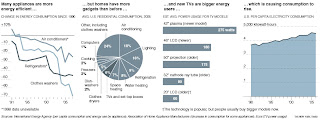
This dramatic increase in the use of electricity consuming devices makes it imperative that there be stricter energy efficiency standards on newer electrical devices. Presently, many of the newer generation of electronic products like flat screen TVs and video game consoles, which are energy guzzlers, have no efficiency standards anywhere.
These are examples of classic negative externalities - in so far as these new generation devices impose a disproportionately larger burden on global energy reserves and the environment. In the absence of regulatory controls, such devices will continue to proliferate and expand at the same or faster pace. Therefore, as with any such negative externality, the solution lies in getting the producers to internalize the full external costs of these devices.
Manufacturers of these devices, who oppose stricter standards on the grounds that it would increase costs and stifle innovation, and its users should be made to fully internalize the external costs by spending resources to improve the energy efficiency and by paying higher prices comensurate with use of cleaner technologies, respectively.
No comments:
Post a Comment